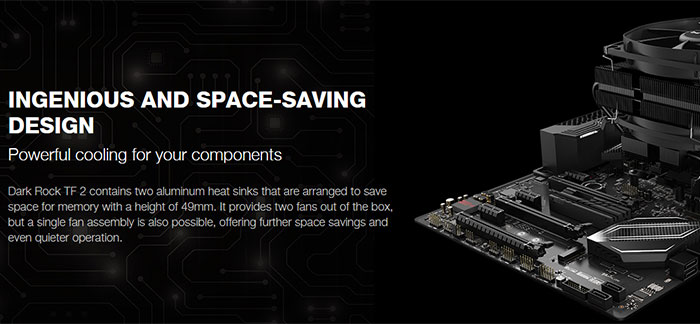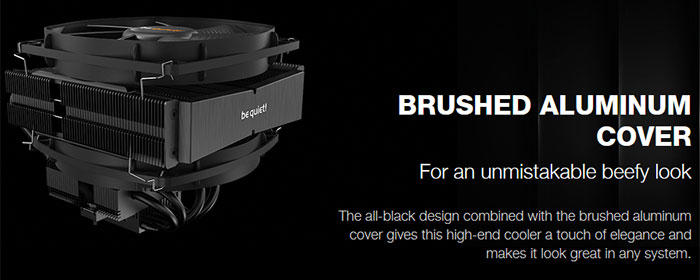German PC cooling, cases and PSUs specialist be quiet! has announced an updated Dark Rock CPU cooler. The new Dark Rock TF2 builds on the top flow design of its predecessor from 2015, with a new dual-heatsink design, which is a slightly different shape and adds approx 17 per cent more weight to the product. Thanks to the various refinements, the TDP rating for the Dark Rock TF2 is a little higher than its predecessor, at 230 vs 220W.

Key features of the new be quiet! Dark Rock TF2 are its high-end performance thanks to the dual-heatsink design, six high-performance 6mm heat pipes, and dual Silent Wings 135mm fans. Of course, the new design uses the latest Silent Wings 3 fans, upgraded from the first edition of this fan series. Be quiet! also highlights how stylish the new Dark Rock TF2 is, with brushed aluminium top cover plus special black coating with embedded ceramic particles.

Official Dark Rock TF2 highlighted feature bullet points
- Extremely high cooling performance with 230W TDP
- Two heat sinks with anti-vibration rubber inserts
- Six high-performance 6mm heat pipes
- Silent Wings 3 135mm with funnel shaped air-inlet and a Silent Wings 135mm for virtually inaudible operation of max. 27.1dB(A)
- Optimized mounting system makes for an easy installation
- Special black coating with ceramic particles enables perfect heat transfer
- Brushed aluminium top cover for elegant look
- Three-year manufacturer's warranty
- Product conception, design and quality control in Germany

If you are considering the be quiet! Dark Rock TF2, the size/weight is 163 x 140 x 134mm and 945g, with fans installed. The manufacturer states that the cooler is compatible with Intel 1200 / 2066 / 1150 / 1151 / 1155 / 2011(-3) Square ILM, and AMD AM4 / AM3(+) sockets. Noise levels across a sample range of fan speeds are as follows; 50 / 75 / 100 per cent PWM generates 11.1 / 19.7 / 27.1dB(A) noise levels. be quiet! supplies this cooler with pre-applied thermal grease, mounts for Intel/AMD, and instructions in English and German (other languages online).

The new be quiet! Dark Rock TF2 will become available starting from 10th August worldwide. Its MSRP has been set at $85.90/€85.90/£79.99. Thus, pricing in the UK hasn't changed compared to the previous version.
Earlier this week, HEXUS reviewed the be quiet! Shadow Rock Slim 2 which, thanks to its accessible £44 ticket price and competent performance, won a HEXUS Good Value Award.













